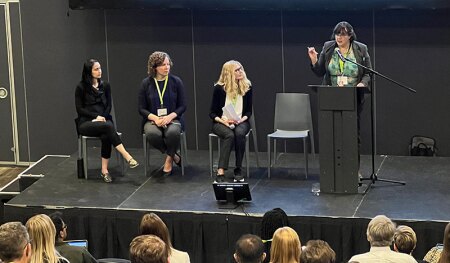
From left to right: Joy Sinderbrand, senior vice president for capital programs, New York City Housing Authority; Krista Egger, vice president of Building Resilient Futures at Enterprise Community Partners; moderator Cherise Burda, executive director of City Building Toronto Metropolitan University; and Lauralyn Johnston, manager of Tower Renewal, speaking at the ULI Resilience Summit in Toronto.
ULI’s fourth annual Resilience Summit, held on Monday in Toronto, featured a panel of affordable housing and climate crisis experts that was moderated by Cherise Burda, executive director of City Building Toronto Metropolitan University, that spoke to solutions in the face of sobering odds.
Krista Egger, vice president of building resilient futures at Enterprise Community Partners, said that more than 45 million homes were at risk last year, with 18 climate disasters that each cost more than $1 billion in damages, costing more than $165 billion in damages in total.
“These climate events and the rising cost of insurance and the rising rates of folks who are uninsured are just exacerbating risks altogether,” she said.
Enterprise’s three strategic priorities to tackle the issue: 1) increase the supply of affordable housing; 2) advance racial equity and housing programs and practices; and 3) build resilience in an affordable housing development community. The U.S.-based national nonprofit organization focuses on all things related to affordable housing, ranging from financial management and program development to policy advocacy across the country.
“One of the phrases that we like to lead with is that ‘when we build a resilient home, we build a better future for everyone,’” Egger said.
She pointed to a recent report that found that the per-hour housing wage in the United States is $25.82 on average, meaning the amount that someone would need to earn per hour to pay a third of his or her income for housing.
“Some of the solutions we’re working on are pairing mitigation practices with adaptation” to make sure that the homes they build do not contribute to climate change, and are prepared to withstand the impact of climate change for the people living there, Egger said.
Tower Renewal
Lauralyn Johnston is manager of Tower Renewal, a city program that helps residents and owners of older apartment towers make improvements that increase energy efficiency and reduce greenhouse gas emissions while improving tenant comfort. That mission is against the backdrop of a city with an affordable housing crisis that has resulted in Toronto councilors last week declaring a homelessness emergency.
Nearly half a million Torontonians live in towers built prior to 1986 and therefore prior to modern code. These towers stand over seven stories tall, average 240 units per building, and represent some of the most affordable housing in the city. “Most lack air conditioning,” Johnston said. Resilience becomes a central concern as people experience longer and hotter, drier heating periods coupled with “the vulnerable populations of seniors, newcomers, [and] people who aren’t climate adapted,” she added.
The current program originated in 2008 with a program called Tower Renewal. “It had a broad environmental focus, social focus. And basically, it was bringing together lots of different partners to take a look at these towers and improve them very much environmentally,” Johnston said. “And as we progressed, we realized the social pieces and social determinants of health/food/justice, and so we brought together a whole bunch of those different things in the years coming back to council.”
Because of the age of the buildings, which have lower rents and cap rates, building operators could not afford to finance needed retrofits to make the properties safe.
In 2018, a fire in St. James Town displaced an entire building’s worth of tenants “that ended up being not only expensive to the building owners, and to the residents who were displaced, but also to the city itself as we dealt with that emergency as a human emergency. The fire was caused by flooding.”
As it works to create more resilient buildings while keeping them affordable, the program is intended to bring all the properties to net zero by 2040. By 2040, 80 percent of the buildings that existed will still exist, “which means that we need to look at how do we retrofit things sustainably?” From that, the finance program was created.
New York City Housing Authority
Joy Sinderbrand is senior vice president for capital programs at the New York City Housing Authority—North America’s largest housing authority, which owns 2,500 multifamily buildings with a stated physical need of upgrades valued at about $40 billion as of 2017. “Public housing is for very low or low income. It is in a state of significant disrepair,” she said.
They do not have a lot of turnover and are considered the housing of last resort for frontline workers. The city’s climate adaptation program covers 35 developments. The housing projects were erected in the 1930s, 1940s, and 1950s, long before disasters like Hurricane Sandy and the advent of modern code. Work is done with tenants in place, if possible.
“Most of our buildings are going to be the buildings that people will be living in. Climate change gets worse and worse. And so, we need to be able to figure out how to adapt,” Sinderbrand said, noting that adaptations include withstanding storm surge and power outages.





